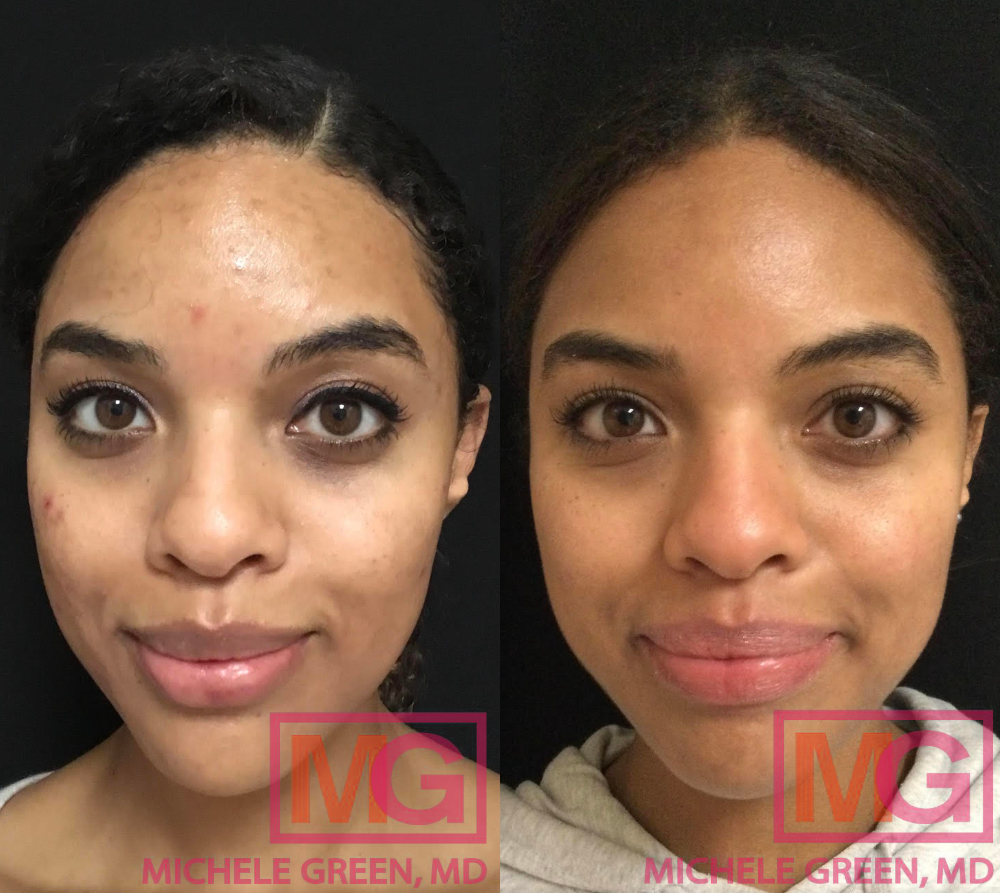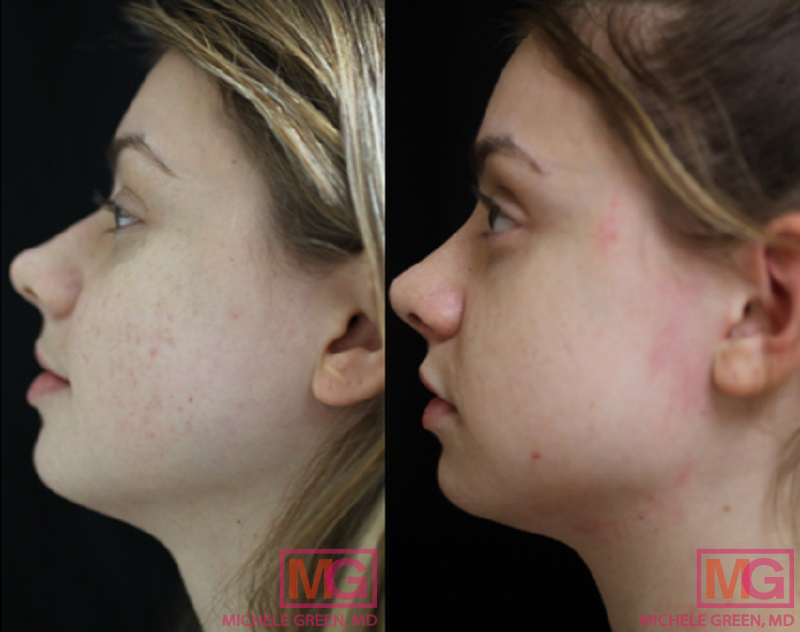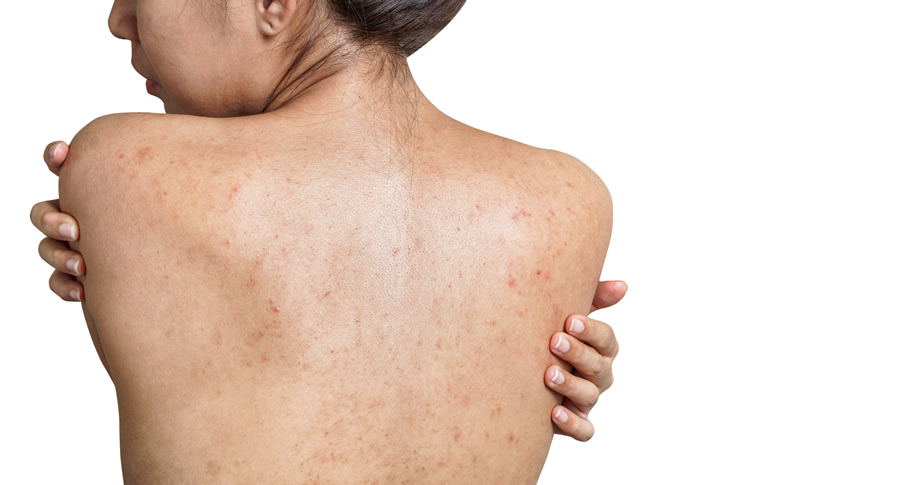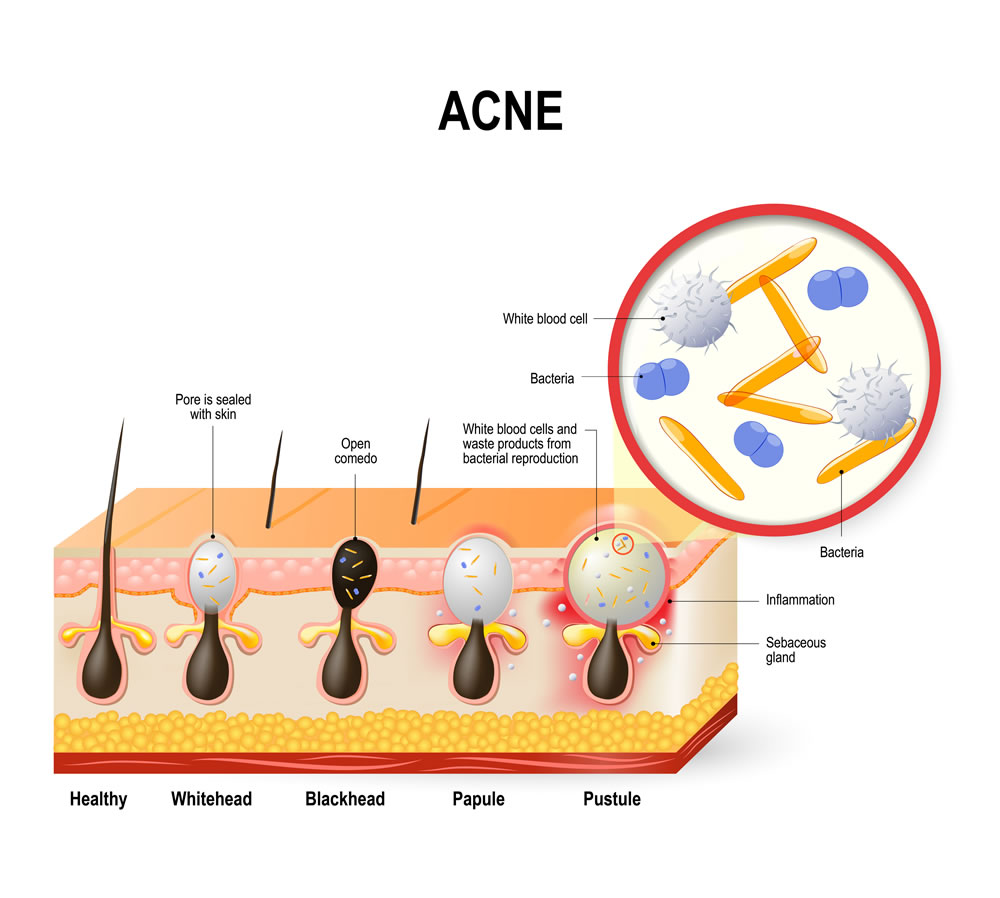Does Sweat Cause Acne?
Summer provides opportunities for beach days, barbecues, and relaxing in the sun, but when the sun is out and heat and humidity are high, it can be difficult to keep sweat from building up, and along with it, you may start to notice sweat acne breakouts. Characterized by red or pink bumps, sweat acne breakouts are the result of sweat accumulation remaining on the surface of the skin and clogging the pores, or skin irritation from sweat combined with friction from sports equipment or clothing. Acne breakouts are one of the most cool reasons that patients consult expert dermatologist, Dr. Michele Green, in her Upper East Side NYC office. Unlike traditional acne, sweat acne is caused by the buildup of sweat or friction on the skin rather than hormonal shifts, meaning sweat acne breakouts can affect patients of any age. While the development of sweat pimples can be frustrating, there are many treatment options and easy behavioral changes that can be made to prevent future breakouts.
According to research published by the American Academy of Dermatology (AAD), more than 50 million Americans suffer from acne breakouts every year. When it comes to sweat acne, there are several biological risk factors that contribute to breakouts, including how acne-prone your skin is, your gender, and the amount you sweat, as well as certain behavioral factors. As such, treatment for sweat acne can be as simple as changing certain behaviors surrounding your workout and adopting a skincare routine that will nourish and protect your skin. For cases that are more persistent, it may be best to visit an expert dermatologist, such as Dr. Michele Green, who can create the treatment plan that will best suit your needs.
Experienced, board certified dermatologist, Dr. Michele Green, has been expertly treating patients‘ acne in her Upper East Side dermatology practice for more than 25 years. With her proprietary line of MGSKINLABS, Inc. line of skin care products, Dr. Green has a wide range of products and treatments available for all forms of acne, including treating clogged pores, blackheads, and sweat pimples. In addition to helping patients develop skincare routines that keep their skin looking young and clear, Dr. Green is also an expert in a wide variety of cosmetic treatments, including dermal filler injections, Botox, and laser skin treatments. Consistently voted as one of the best dermatologists in New York City by Castle Conolly, Super Doctors, and New York Magazine, Dr. Green works tirelessly to deliver the best, individualized care to all her patients.
Can sweat make you break out?
While some level of sweating can be helpful in keeping your skin clear, allowing sweat to build up and remain on your skin can have the opposite effect. Sweat, which is composed of water, salts, sugars, ammonia, and urea, is secreted by the eccrine sweat glands to keep you from overheating on a hot day or after a strenuous work out. If sweat is kept on your skin for prolonged periods of time, the excess sweat can trap acne-causing bacteria, oil, and dirt in place on the skin and contribute to clogging the pores, especially if there is added friction from sports equipment or tight clothing. Sweat acne can occur both in patients with already acne-prone skin and for patients who do not experience acne breakouts on a regular basis.
What is Sweat Acne?
Sweat acne is a specific type of acne that appears as a result of sweat remaining on the surface of the skin. Acne blemishes are a skin condition that develop when bacteria, dead skin cells, and sebum produced by the sebaceous glands clog the pores, leading to comedones or inflammatory acne. When sweat is able to remain on the skin for any extended amount of time, it traps bacteria and debris on the surface of the skin, increasing the likelihood that the pores will be clogged and a breakout will occur. Sweat acne can also arise when sweating is combined with friction, pressure, or rubbing that occurs when athletic equipment is in contact with the skin or other physical objects, such backpack straps or tight clothing. This type of acne is known as acne mechanica, and it differs from traditional acne vulgaris in that it is caused specifically by “mechanical means” (friction, rubbing) as opposed to shifts in hormones.
What do sweat pimples look like?
Sweat pimples, or zits, can take on several forms but often look like irritated red or pink bumps on the skin where sweat has accumulated as opposed to the blackheads that you would often see with traditional acne. Acne mechanica, which is caused when sweaty areas of the body are exposed to friction from work out or athletic equipment such as helmets, headbands, or tight clothing, frequently appears as papules, pustules, or nodules. Papules and pustules are forms of inflammatory acne, which occur when pores are clogged with bacteria, causing infection and inflammation. Papules and pustules both take on the appearance of red bumps but differ in that pustules often have a white top and are filled with pus. If the infection becomes more severe, nodules may occur as a result of mechanica acne, which are typically more painful and deeper lesions.

Where are sweat acne breakouts most common?
Sweat acne breakouts occur on locations of the body where sweat glands are most prevalent, which includes the face, armpits, neck, and groin area, as well as where sweat is most likely to accumulate, including between skin folds and under the breasts. Acne mechanica most commonly occurs in locations where the body is rubbing up against sports equipment or other physical objects. For example, athletes who wear helmets may be more likely to develop sweat acne on the forehead and along the chin where the strap comes in contact with the skin. Other objects that can commonly contribute to the development of sweat acne include backpacks, belts, tight sweaty clothes, and hats.
What are common risk factors for developing sweat pimples?
There are some biological factors and some behavioral factors that can contribute to your risk of developing sweat pimples. Biologically, you may be more likely to develop sweat acne if you already suffer from acne vulgaris, meaning you have a more acne-prone skin type. Sweat and friction can irritate pre-existing acne on the skin and lead to more inflamed pre-existing outbreaks. Patients who suffer from excessive sweating are also at a higher risk of developing sweat pimples due to a higher amount of sweat being produced throughout the body. Similarly, gender can play a role in risk of developing sweat acne as men are more likely to produce a higher amount of sweat than women. While men and women do have the same number of sweat glands, typically, the sweat glands on women’s body necessitate a higher temperature to produce sweat than men’s glands.
There are also several behavioral factors that can contribute to an outbreak of sweat acne. Sweat acne can frequently occur after a workout, particularly if you are wearing tight clothing with no moisture-wicking capabilities. Tight clothes can trap sweat inside and create friction as they rub up against your skin, two factors that contribute to the development of sweat acne. Further, if you stay in sweaty clothes for an extended amount of time after sweating, this can also contribute to acne as the sweat remains in contact with your skin. Having other products on your skin, such as make up and sunscreen, before working out or being in a hot environment can also contribute to sweat acne breakouts. The sweat can cause dirt, dead skin, make up, and sunscreen to be trapped on the surface of the skin and clog the pores. With these behavioral factors, however, there are easy steps that can be taken to help prevent the breakout of sweat pimples.
How to prevent acne from sweating
There are several behaviors that are easy to change that can help to prevent acne breakouts from sweating:
Wear loose-fitting clothing – On a hot day or before a workout, one of the easiest ways to reduce the risk of developing sweat acne is by wearing loose-fitting, moisture-wicking clothing. Tight clothing can trap sweat against your body, which can irritate the skin and clog the pores, so it is best to wear loose, breathable materials.
Wear oil-free sunscreen – Sunscreen is not only imperative in protecting against harmful UV rays and preventing skin cancer, but wearing sunscreen can also reduce your risk of developing acne. Direct exposure to the sun can dry out your skin, which leads to the increased production of sebum. This excess oil can contribute to clogged pores and acne breakouts. When choosing a sunscreen, it is best to select an oil-free sunscreen, with a label that says “non-comedogenic,“ of at least SPF 30.
Dab with a clean towel during your workout – During your workout, you can help to reduce the amount of sweat on your body by dabbing your face with a clean towel. It is important to dab, not rub or wipe, your face, as rubbing or wiping can cause skin irritation. Make sure you are using a clean towel as unwashed towels can carry acne-causing bacteria that you may inadvertently transfer to your skin.
Change into clean clothes after sweating – After a workout or spending time in a hot environment it is important to change into clean clothes as soon as possible. Sweaty clothes can trap sweat, dirt, and bacteria on the surface of the skin, leading to potential outbreaks. You should also be sure that you are always choosing clean work out clothes to wear before each workout session. Clothing that has been worn before can carry acne-causing bacteria from the last time you sweat, leading to a higher risk of developing sweat acne.
Avoid shared equipment – Sports and workout equipment can carry harmful, acne-causing bacteria on the surface, and, as such, sharing equipment such as helmets, jerseys, or workout machines without wiping them down or washing them first can contribute to the development of sweat acne.
Shower post-workout – After an intense workout or a day spent somewhere hot, it is important to shower as soon as possible to prevent acne outbreaks. Patients should be advised to wash their face with a gentle, non-comedogenic cleanser that should be carefully applied to the skin to avoid irritation.
Hydrate when it‘s hot – Warm weather, hard exercise, and exposure to the sun can all dry out the skin. When the skin is dry, the sebaceous glands will produce excess oil, known as sebum, to compensate, which can clog the pores. In addition to wearing oil-free sunscreen, staying hydrated by drinking water throughout the day can help to prevent build-up of excess sebum.

Acne treated with eMatrix
How to get rid of sweat pimples
Once sweat pimples have developed on the surface of the skin, there are many treatment options available either over-the-counter or as a prescription from a dermatologist’s office. If you are unsure about what treatment option is best for you, you can consult with a board-certified dermatologist, such as Dr. Green, who can create a treatment and skincare routine to best address your needs.
Salicylic Acid – Salicylic acid is very useful in exfoliating the skin to remove dead skin cells that can clog pores and reduce the production of sebum. Composed of hydroxy acid, Salicylic acid is oil-soluble and has anti-inflammatory properties, making it an ideal solution to speed up the healing of sweat pimples. Salicylic acid is an ingredient in many over-the-counter creams or ointments in different strength concentrations.
Benzoyl Peroxide – Benzoyl peroxide is another common acne-fighting ingredient found in many topical creams and ointments in varying concentrations. In addition to removing excess oil and dead skin cells, benzoyl peroxide has anti-bacterial properties, meaning it is ideal to address inflammatory acne, such as sweat acne. When applied, benzoyl peroxide can also keep new breakouts of acne but dries out the skin more than salicylic acid. For that reason, it is also important to pair with an oil-free moisturizer.
Retinoids – Retinoids can also be administered in different concentrations and work to unclog pores and promote new skin cell production. At lower concentrations, retinoids can be applied topically in over the counter creams, such as retinol. For particularly persistent or pervasive breakouts of sweat acne, retinoids can be taken as an oral medication prescribed by your dermatologist.
How to get rid of sweat pimples on the forehead
There are many treatment options when it comes to eliminating sweat acne on the forehead. Sweat often accumulates along the hairline and clothing or sports equipments, such as hats or helmets, can trap sweat along the forehead. The first step for treatment is to make sure to clean the area as soon as possible after a heavy workout or being in a hot environment. Using a gentle cleanser, patients can lightly clean the area – as opposed to scrubbing, which can further irritate the skin. If acne persists, products containing salicylic acid or benzoyl peroxide can be applied to the affected area.
How to get rid of sweat acne on the arms and back
When looking to get rid of sweat acne on the arms, back, and chest, Dr. Green will recommend a combination of skincare products to keep your skin clean and moisturized, behavioral changes surrounding workouts, and topical or oral acne-fighting medication. When addressing sweat acne of the arms, back, and chest in particular, it is important to remember to wear loose-fitting, moisture-wicking clothing in order to prevent the buildup and accumulation of sweat in those areas. When you have your consultation with Dr. Green, she will be able to determine the best skincare products to address your breakout.

How to get rid of sweat bumps on the buttocks
One of the most common places for sweat acne to develop is on the buttocks, due to the high concentration of sweat glands there. Developing sweat acne on the butt can make patients feel self-conscious but Dr. Green often assures patients that the condition is quite common and she has many treatment options available. Like other areas of the body that are prone to sweat acne, it is important to keep the affected area clean. Patients can use anti-bacterial soap, cleansers with benzoyl peroxide and gentle exfoliating skincare products in order to promote clear and healthy skin. There are also topical or oral antibiotics available for more persistent cases. For topical antibiotics, Dr. Green may prescribe clindamycin or erythromycin lotion or combine topical antibiotics with benzoyl peroxide gel. For deeper infections, Dr. Green may prescribe oral antibiotics, doxycycline or minocycline.
Sweat acne vs. heat rash bumps
While the prevalence of sweat on the body can lead to breakouts of acne, heat rash can also cause acne-like bumps to appear on the skin. Both sweat acne and heat rash commonly appear on days that are hot and humid when you are more likely to sweat. While sweat acne is caused by sweat trapping bacteria, dead skin, oil and other debris on the skin and clogging the pores, heat rash is caused when the sweat ducts get clogged and sweat is trapped under the skin. When this occurs, heat rash resembles a section of acne-like red bumps on the surface of the skin. Most commonly, heat rash will appear on the chest, back, or neck and should be treated differently than sweat acne.
How to get rid of sweat bumps on the forehead
If the sweat bumps that appear on the forehead are heat rash and not sweat acne, the first thing to do would be to remove yourself from the hot environment. Find a location that is cool and dry so that your body can regulate your temperature. In most cases, the heat rash will disappear once your body has cooled down, however, in some more extreme cases, you should be advised to visit your dermatologist. Patients who come to Dr. Green with heat rash that does not resolve on its own may be prescribed topical steroids or calamine lotion.
Is sweating good for acne?
Sweating can be good for your skin, as it helps to open up the pores and can work to remove a buildup of acne-causing bacteria and dirt that may be clogging the pores. However, if sweat dries and remains on your skin, it can actually have the opposite effect, leading to a breakout of sweat pimples. In order to maximize the helpful effects of sweating, it is important to wear loose clothing, clean any clothes or equipment that comes in contact with your skin between uses, and shower as soon as possible after a workout or being in a hot environment to prevent the build up of sweat on the body.
Does sweating clog pores?
Sweating on its own does not clog pores, however, if sweat is left to dry on your skin or you stay in sweaty clothes for a prolonged period of time, it is possible for sweat to contribute to clogging your pores. When sweat stays on the surface of the skin, it traps the debris, bacteria, and oil that is already present on your skin. This debris on the skin can clog the pores, which, in turn, leads to inflammation and a breakout of acne.
Does sweating help acne?
Patients often wonder, does sweating get rid of acne, and the answer is: it depends. Sweating is an important function of your body – not only does it help to keep you cool in warm temperatures, but it can open the pores and wash away debris from the surface of the skin. The highest concentration of sweat glands are found in areas that require the cooling effects most, including the face, arm pits, and groin area. Patients who wear loose-fitting clothes, use a clean towel to dab sweat away during a workout, and who shower with a non-comedogenic cleanser post-workout will find that these practices can help to reduce the amount of acne breakouts.

Does sweating make acne worse?
Unfortunately, when the proper prevention steps are not taken, sweating can make acne worse – particularly for patients who are already acne-prone. Acne mechanica occurs when sweat combined with friction or rubbing creates pustules, papules, and, in some cases, nodules on the skin. When patients sweat and there is any friction between objects, such as a backpack, hat, tight clothing, or sports equipment, this can cause pre-existing acne to become even more irritated and flare up. That is why it is important to always clean equipment between use and avoid tight-fitting clothing when possible.
How to get started with sweat acne treatment
Sweat acne is a common skin condition that results in red bumps, pastules, or pustules at locations across the body where sweat has accumulated. It can affect patients of any age and gender and be a nuisance to endure. Luckily there are many easy behavior changes that patients can make to reduce the likelihood of sweat pimple breakouts. For patients who want more information about treating sweat acne or who are struggling with a particularly pervasive case, expert, board-certified dermatologist, Dr. Green, can help. Please contact us online or call 212-535-3088 to learn more about about the most effective sweat acne treatments for you.
 212-535-3088
212-535-3088